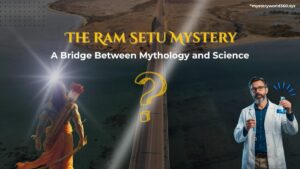The Ram Setu Mystery – A Bridge Between Mythology and Science

The Ram Setu mystery has captivated millions of people across the globe. Known also as Adam’s Bridge, this ancient structure stretches from the southeastern coast of Tamil Nadu, India, to the northwestern coast of Sri Lanka. While many call it a mythological wonder, others debate it as a natural geological formation. Whether you’re a history buff, a spiritual seeker, or a science enthusiast, the Ram Setu mystery pulls you into a world where ancient epics meet modern technology, and where faith clashes—or harmonizes—with fact.
In this article, we will delve deep into the Ram Setu mystery, examining the origins, mythology, scientific theories, controversies, and ongoing debates surrounding this enigmatic formation.
Origins of the Ram Setu Mystery
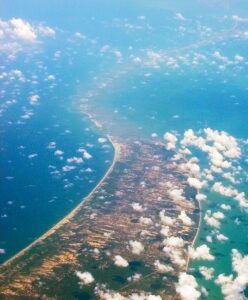
The Ram Setu mystery finds its roots in the ancient Hindu epic, the Ramayana.The bridge was said to be built using floating stones that bore the name of Lord Rama.
The existence of such a bridge, corroborated by satellite imagery and ancient texts, has made the Ram Setu mystery a subject of immense interest. Though the Ramayana dates back thousands of years, its references to this bridge have stirred debates about the line between mythology and historical reality.
Satellite Evidence and the Ram Setu Mystery

In the early 2000s, NASA satellite images revealed a chain of limestone shoals between India and Sri Lanka. These formations appeared to be man-made or at least arranged in a linear pattern. This led to a resurgence of curiosity and further cemented the Ram Setu mystery in the global spotlight.
Many proponents of the Ram Setu mystery argue that the alignment and composition of the structure are too precise to be natural. They believe that the bridge’s linearity, coupled with its historical references, proves its man-made origins. However, NASA has not officially endorsed any claims linking the formation to Lord Rama.
Geological Perspectives on the Ram Setu Mystery

Geologists have their own theories about the Ram Setu mystery. According to scientific analysis, the bridge may have formed naturally through a process called sedimentation, where sandbanks and limestone shoals gradually built up over time. Some studies suggest the formation could be over 7,000 years old—older than many ancient civilizations.
Yet, the geological explanation does not entirely dismiss the Ram Setu mystery. In fact, some geologists have openly admitted that the bridge’s formation remains puzzling. The structure’s unique features and the presence of floating stones add layers to the already complicated Ram Setu mystery.
The Floating Stones and the Ram Setu Mystery

Devotees and believers claim that these are remnants of the original Ram Setu, blessed by Lord Rama’s divine name.
Scientists have attempted to explain this feature through the presence of pumice—volcanic stones that are porous and lightweight
Whether divine or geological, the floating stones continue to stoke the fire of the Ram Setu mystery, keeping it alive in popular culture and academic circles alike.
Political Controversies Surrounding the Ram Setu Mystery
The Ram Setu mystery has not remained a purely scientific or spiritual topic; it has also taken on political dimensions. In the 2000s, the Indian government proposed the Sethusamudram Shipping Canal Project, which aimed to dredge the shallow waters around the bridge to allow ships to pass through.
This led to widespread protests, particularly from religious groups who viewed the Ram Setu mystery as a sacred heritage site. The opposition argued that destroying the bridge would be akin to erasing a vital piece of Indian identity and history. Eventually, the project was stalled, and the Ram Setu mystery once again became a subject of national debate.
Ram Setu Mystery in Pop Culture and Media

The Ram Setu mystery has also found a home in pop culture. From documentaries to Bollywood films, the legend of the bridge has been romanticized, scrutinized, and dramatized. In recent years, movies like Ram Setu (2022), starring Akshay Kumar, have attempted to bring the Ram Setu mystery to mainstream attention.
To many Hindus, the Ram Setu mystery is not a mystery at all but a sacred truth. It serves as a physical testament to Lord Rama’s journey and the ultimate victory of dharma over adharma (good over evil). Pilgrimages to Rameswaram often include visits to Dhanushkodi, where believers feel the presence of divinity amid the ruins.
The Ram Setu mystery thus transcends mere science or myth. It has spiritual weight, grounding the beliefs of millions and serving as a symbol of faith and resilience.
Modern-Day Expeditions and Research into the Ram Setu Mystery
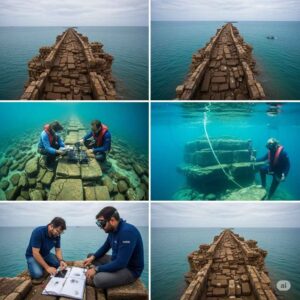
In recent years, archaeological and oceanographic studies have resumed to unravel the Ram Setu mystery. The Indian Council for Historical Research (ICHR) and other academic bodies have launched studies using sonar imaging and carbon dating techniques to ascertain the age and origin of the structure.
Some findings suggest human activity in the region dating back more than 5,000 years.Unanswered Questions in the Ram Setu Mystery
Despite all the advancements in technology and historical research, several questions remain unanswered in the Ram Setu mystery:
- Is the bridge entirely natural, or was it modified by human hands?
- Why do some stones float while others sink?
- Can we definitively link the bridge to the Ramayana?
Each of these questions keeps the Ram Setu mystery alive, fueling discussions in temples, classrooms, and labs alike.
🛕 What is the Mystery Behind Ram Setu?
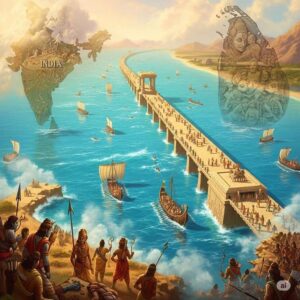
The Ram Setu mystery is one of India’s most intriguing and controversial topics, blending mythology, science, faith, and politics. Known also as Adam’s Bridge, Ram Setu is a 48-kilometer chain of limestone shoals connecting Rameswaram Island in India to Mannar Island in Sri Lanka. But here’s where it gets mysterious — is it a natural formation, or was it built by Lord Rama’s Vanara Sena as described in the Ramayana?
Let’s dive deep into the mind-blowing secrets of the Ram Setu mystery that continue to baffle both scientists and devotees.
📖 Mythological Origin of Ram Setu

According to the Hindu epic Ramayana, written by Sage Valmiki, Lord Rama needed to cross the ocean to rescue his wife Sita from the demon king Ravana, who ruled Lanka. Rama’s army of monkeys (Vanaras), led by Lord Hanuman, Nala, and Neela, constructed a massive floating bridge to Lanka — this came to be known as Ram Setu.
✨ The epic describes that the bridge was:
- Built using floating stones inscribed with Rama’s name
- Completed in just five days
- Wide enough for the entire army to cross
This forms the heart of the Ram Setu mystery — can such a structure really exist?
🧪 Scientific Studies on the Ram Setu Mystery

Now let’s bring science into the picture.
🔍 Key Scientific Findings:
- NASA satellite images show a man-made looking chain of shoals visible from space.
- Studies by geologists indicate that the sandbar formation is around 7,000 years old.
- However, limestone and coral samples from the surface are only 500–600 years old.
This leads to a puzzling contradiction — the base is ancient, but the top layer seems newer.
This fuels the Ram Setu mystery: Did humans modify a natural formation? Or was it an ancient engineering marvel?
🌊 The Floating Stones Mystery
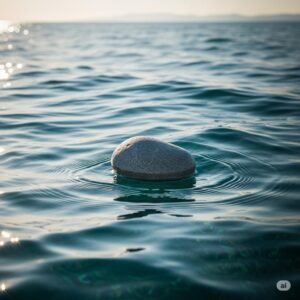
Local folklore in Rameswaram claims that the stones used in Ram Setu can float on water. In fact, tourists and pilgrims often spot “floating stones” sold near the Ramanathaswamy Temple.
🔍 Is Floating Stone Real?
- These stones are pumice, a volcanic rock with trapped air pockets — which can float.
- But India doesn’t have nearby active volcanoes that could have created pumice in such quantities.
This unexplained presence of floating stones adds another bizarre layer to the Ram Setu mystery.
🚧 Controversies Around Ram Setu

The Ram Setu mystery became a national debate due to the proposed Sethusamudram Shipping Canal Project, which aimed to cut through the bridge for easier shipping routes.
🔥 Religious vs Rationalist Views:
- Devotees: Believe Ram Setu is sacred proof of the Ramayana’s truth.
- Scientists/Government Bodies: Initially claimed it’s a natural sandbar.
In 2007, the Archaeological Survey of India (ASI) controversially said there’s no historical evidence that Ram Setu was built by Lord Rama — sparking protests across India.
🔮 Is Ram Setu Man-Made or Natural?
This question is still unanswered, keeping the Ram Setu mystery alive.
Arguments for Man-Made:
- Straight alignment (almost too perfect)
- Ancient texts supporting its construction
- Religious and oral traditions
Arguments for Natural:
- Geological formations of coral and sandbars are common
- Floating stones could be naturally formed pumice
🛕 Ram Setu in Pop Culture & Media
The 2022 Bollywood film “Ram Setu” starring Akshay Kumar fictionalized the archaeological quest to protect the bridge, boosting global interest in the Ram Setu mystery.
It also spurred questions like:
- Is Ram Setu the world’s oldest man-made bridge?
- Is there hidden technology or divine energy behind it?
🧘♂️ Spiritual Significance of Ram Setu
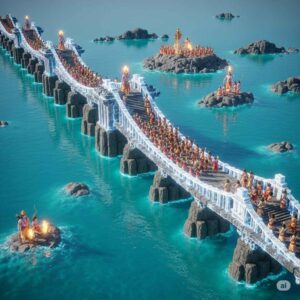
For millions of Hindus, Ram Setu isn’t just a bridge — it’s a spiritual path, a symbol of faith and divine intervention. The Rameswaram Temple, one of the Char Dhams, is closely associated with the story.
Pilgrims believe visiting this sacred region washes away sins and brings liberation (moksha). This religious energy continues to power the enduring Ram Setu mystery.
❓ Unanswered Questions That Fuel the Mystery
- Why do floating stones appear only in this region?
- Why does science have conflicting data about the age of the bridge?
- Could ancient technology or divine intervention really be behind it?
Is the Ram Setu Based on a True Story?
🔥 The Big Question: Is the Ram Setu Real or Just a Myth?
The Ram Setu mystery has captivated historians, archaeologists, spiritual seekers, and scientists for decades. The bridge described in the Hindu epic Ramayana, said to be built by Lord Rama’s Vanara Sena, seems to actually exist in the real world — as a chain of shoals connecting India and Sri Lanka.
But does this mean the events of Ramayana are literal history? Or is the Ram Setu a natural formation that became a part of India’s greatest epic?
📚 Ramayana’s Claim: A Divine Bridge Built by Rama’s Army

According to the Valmiki Ramayana:
- Lord Rama’s army, with the help of Nala and Neela, constructed a bridge across the ocean to reach Lanka (now Sri Lanka).
- The bridge was made of floating stones with Rama’s name written on them.
- It was completed in 5 days, and was wide and sturdy enough for the entire army.
🛰️ Scientific Evidence: What Do Modern Studies Say?
Several scientific and satellite-based studies have investigated the structure we now call Adam’s Bridge (Ram Setu).
🔍 Key Scientific Findings:
- NASA satellite imagery shows a visible bridge-like structure in the ocean.
- Studies show that the sandbar underneath is 7,000+ years old, but the rocks above are only about 500 years old — raising questions about man-made intervention.
🧪 Controversial Point:
While some geologists say it’s a natural formation, others suggest that the alignment, age variation, and stone types could imply artificial modification — meaning humans may have built or modified it.
This keeps the Ram Setu mystery alive: Natural or man-made?
🪨 What About the Floating Stones?
Another part of the Ram Setu mystery is the existence of floating stones found near Rameswaram. These are sold to tourists and said to be used in the bridge.
🔬 Scientific View:
- These stones are often pumice, a volcanic rock filled with air cavities.
- But India has no nearby volcanoes, so the source of these stones remains unclear, especially in such large quantities.
So, science can’t fully explain their presence, and belief in divine intervention continues.
🧘 Believers’ View: Ram Setu Is Proof of Ramayana’s Truth
For millions of Hindus, the Ram Setu mystery is not just about rocks and water. It’s a living symbol of faith that validates the Ramayana as a true historical account, not mere mythology.
Many saints and scholars believe:
- The Ramayana is Itihasa — not fiction, but actual history.
- Ram Setu’s physical presence proves the events happened thousands of years ago.
🤯 The Time Gap Mystery
Now here’s where it gets truly mysterious:
| Element | Age Estimate |
| Sand base (underwater) | ~7,000 years old |
| Coral/rock layer | 500–1,200 years old |
| Ramayana timeline | ~5,000–7,000 years ago (Treta Yuga) |
This timeline makes many wonder — was there an ancient structure built long ago, whose traces still exist underwater?
This fuels the belief that Ram Setu is based on a true story — supported by a real, ancient structure that aligns with the epic.
⚖️ What the Indian Government Says
- In 2007, the Archaeological Survey of India (ASI) said there is no definitive evidence that the bridge was built by Lord Rama.
- However, due to public backlash and religious sentiments, later statements by the Supreme Court and government acknowledged that Ram Setu is of national importance and should not be destroyed.
This shows how even the government acknowledges the cultural and mysterious importance of Ram Setu — even if full scientific proof is still pending.
🌍 Global Interest in Ram Setu
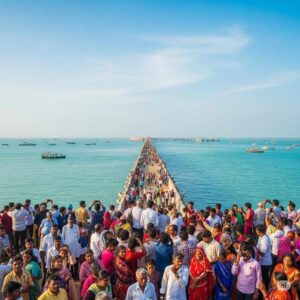
The Ram Setu mystery gained worldwide attention after:
- NASA images went viral
- News channels debated its origins
- The Bollywood film “Ram Setu” (2022) reignited curiosity
Now, people across the globe are wondering:
Is the Ramayana a lost chapter of human history?
❓ Final Verdict: Is Ram Setu Based on a True Story?
✅ YES — if you follow mythology and oral tradition
🧪 MAYBE — if you go by scientific findings
🧘♂️ UNQUESTIONABLY — if you believe in divine engineering
So, while science has not fully confirmed that Lord Rama literally built the bridge, the existence of a real structure that matches the Ramayana’s description makes the Ram Setu mystery one of the most fascinating unanswered questions in human history.
🌊 Is Ram Setu 7000 Years Old?
🕰️ The Short Answer:
Yes, parts of the Ram Setu are believed to be around 7,000 years old, according to some geological and scientific studies — but not all parts of the bridge are that old. This age discrepancy is a key element of the Ram Setu mystery.
Let’s break it down step by step.
🛰️ Scientific Studies That Hint at a 7000-Year-Old Ram Setu
Multiple studies have analyzed the structure beneath the ocean, where Ram Setu (also called Adam’s Bridge) connects India’s Rameswaram to Sri Lanka’s Mannar Island.
🔍 Key Findings:
- The Geological Survey of India (GSI) and some independent researchers found sand and sediment deposits under the bridge that date back to approximately 7,000 years ago.
- The limestone and coral stones placed on top are much younger, around 500 to 1,200 years old.
This means:
- The foundation/base of Ram Setu might be 7,000+ years old.
- The stones above seem to have been placed later, possibly by humans.
📖 What Does the Ramayana Say?
According to Hindu tradition:
- Ram Setu was built in the Treta Yuga, which is estimated by some Indian scholars to be over 7,000 years ago.
- The bridge was constructed by Lord Rama’s Vanara Sena using floating stones, led by Nala and Neela.
This timeline matches the scientific age of the sandbar foundation, fueling belief that Ram Setu is truly 7,000 years old — just like the epic says.
This adds a powerful twist to the Ram Setu mystery:
🧪 Could an epic written thousands of years ago be describing a real-world structure that matches modern geological data?
🧪 Why the Age Discrepancy?
Here’s the core of the Ram Setu mystery:
| Layer of Ram Setu | Estimated Age | Key Material |
| Underlying Sandbar | ~7,000 years old | Ancient sediments |
| Top Layer (stones) | 500–1,200 years old | Coral, limestone |
This raises two big questions:
- Why are the base and top layers from different time periods?
- Did humans use an existing sandbar to build a bridge — just like the Ramayana describes?
💥 What Makes the 7,000-Year Age So Mysterious?
- 🔥 Science can’t explain who placed the stones if they were added by humans over 1,000 years ago.
- 🧱 The alignment is too perfect to be random — it forms a straight line between India and Sri Lanka.
- 🌊 No similar bridge exists naturally in the world, making this formation extremely rare.
So yes — the foundation of Ram Setu may indeed be over 7,000 years old, making it one of the oldest man-altered or used formations in the world. That’s why this is not just a historical question — it’s a global archaeological mystery.
🧘 Faith + Science = Mystery
- Believers say this proves Ramayana is historical, and that Lord Rama truly walked the Earth.
- Scientists agree something strange is going on — but they haven’t reached a final verdict.
🔮 That’s what keeps the Ram Setu mystery alive — a 7,000-year-old secret hidden beneath the sea, waiting to be fully understood.
✅ Final Verdict: Is Ram Setu 7000 Years Old?
- YES, the sandbar foundation is likely 7,000 years old.
- NO, the surface rocks are younger.
- This makes Ram Setu one of the oldest and most debated oceanic structures on Earth.
🔬 What is the Science Behind Ram Setu?
🌊 What is Ram Setu?
Ram Setu, also known as Adam’s Bridge, is a mysterious 50-km chain of limestone shoals that connects Rameswaram in Tamil Nadu, India, to Mannar Island in Sri Lanka. It’s believed by Hindus to be the bridge built by Lord Rama’s Vanara Sena in the epic Ramayana.
The Ram Setu mystery lies in the fact that this structure actually exists, and both science and mythology have wildly different interpretations of its origin.
Let’s explore the scientific side of the story.
🛰️ Satellite Imagery Confirms Its Presence
In the early 2000s, NASA’s Landsat imagery revealed a visible bridge-like formation under shallow waters between India and Sri Lanka. This image triggered global interest in the Ram Setu mystery.
Key points:
- The structure is clearly man-like in alignment.
- It extends across the ocean for nearly 50 kilometers.
- It appears unnaturally straight, which raises questions about its natural origin.
🧪 Geological Explanation: What is Ram Setu Made Of?
Scientists have conducted studies to understand the composition of the Ram Setu structure. Here’s what they found:
🧱 Components of Ram Setu:
- Limestone shoals
- Sandbanks
- Corals
- Boulders resting on a shallow sandbar
⛏️ Geological Theories:
- Natural Formation Theory
- Formed by sediment deposition, wave actions, and coral reef activity.
- Geologists argue that the unique ocean currents in this area might have naturally aligned these features.
- Some say it’s part of a long-submerged land connection between India and Sri Lanka.
- Modified Natural Formation Theory
- Some scientists propose that humans may have used an existing sandbar and strategically placed rocks and stones to stabilize or use it as a bridge.
- This aligns with the Ramayana version — that Rama’s army used natural support and made it walkable.
This theory keeps the Ram Setu mystery wide open — is it nature’s work or divine engineering?
🧭 Age Dating Adds More Confusion
Different scientific studies reveal a mismatch in the ages of the sandbar and the rocks placed on top.
| Layer | Estimated Age |
| Underlying sandbar | ~7,000 years old |
| Coral and stones above | 500 – 1,200 years old |
This age difference adds weight to the theory that someone deliberately placed the rocks over an older natural formation. But who did it? And when? That’s where science still doesn’t have a clear answer.
This age mismatch is at the heart of the Ram Setu mystery.
🪨 The Floating Stone Puzzle
In the regions around Rameswaram, tourists and locals talk about “floating stones” believed to be part of the Ram Setu.
Scientific View:
- These are likely pumice stones, formed from volcanic activity and filled with air pockets that make them float.
- BUT… India has no nearby volcanoes, and the quantity of such stones is unexplained.
Again, science offers a partial answer but fails to explain the full picture, keeping the Ram Setu mystery alive.
🧬 Marine Archaeology and Underwater Studies
Several Indian and international agencies, including:
- National Institute of Oceanography (NIO)
- Geological Survey of India (GSI)
…have conducted underwater surveys.
Findings:
- Tools and carvings resembling ancient work have been found on some rocks.
- Certain parts appear to have been artificially placed.
- But no definitive conclusion has been reached to say it was “built” by a specific ancient civilization.
🧘 Faith vs. Science
🔬 Science Says:
- Ram Setu is a natural formation that may have been used or modified by humans.
- It needs more deep-sea exploration and carbon dating to prove its origin.
🙏 Believers Say:
- The precise alignment, ancient age, and religious texts prove that it’s the real Ramayana bridge.
- It’s not a coincidence that the bridge lies exactly where Ramayana says it was built.
The gap between science and belief is what fuels the global obsession with the Ram Setu mystery.
🌉 Why is Ram Setu Called Adam’s Bridge?
📍 The Two Names: Ram Setu vs Adam’s Bridge
The structure known as Ram Setu in India is also called Adam’s Bridge in many Western and international records.
But why? What’s the real story behind this name change, and how does it relate to the Ram Setu mystery?
Let’s dive into the history, religion, and colonial influence behind the two names of this iconic formation.
🛕 Ram Setu – The Original Name from Hindu Scriptures
In Hindu tradition, the bridge is called “Ram Setu”, which literally means “Rama’s Bridge”. It’s believed to have been built by Lord Rama’s Vanara Sena in the epic Ramayana, to reach Lanka (Sri Lanka) and rescue Sita.
- Built with floating stones by Rama’s army.
- Also called “Setubandha” in Sanskrit.
- Described in the Valmiki Ramayana, dating back thousands of years.
This makes it a sacred site for millions of Hindus and an essential part of the Ram Setu mystery.
✝️ Adam’s Bridge – The Islamic and Western Perspective
The name Adam’s Bridge comes from Islamic and Christian legends that became widespread during Arab trade routes and later British colonial rule.
🔍 The Origin of the Name “Adam’s Bridge”:
According to Islamic tradition:
- After Adam was expelled from Paradise, he fell to Earth in Sri Lanka (specifically on Adam’s Peak, known locally as Sri Pada).
- He then crossed over to India via this natural land bridge to atone for his sins.
- Hence, the structure became known as “Adam’s Bridge” — the path of the first man on Earth.
Later, during the British colonial era, this name was widely adopted in English maps, and even by early European scholars and explorers.
🗺️ Timeline of Name Usage
| Time Period | Name Used | Cultural Influence |
| Ancient Era | Ram Setu / Setubandha | Hindu Scriptures (Ramayana) |
| 9th–15th Century | Adam’s Bridge | Islamic belief in Adam’s path |
| British Rule (1700s+) | Adam’s Bridge (common in maps) | Colonial naming & geography |
| Modern India | Ram Setu | Religious and national identity |
🇮🇳 Current Status: Which Name is Official?
In modern times:
- Indian religious groups and scholars prefer Ram Setu, as it’s tied to Hindu heritage.
- The name Adam’s Bridge is still used internationally, especially in older maps and scientific papers.
- In recent years, there has been a strong movement to recognize it officially as Ram Setu.
This dual identity is part of what makes the Ram Setu mystery so intriguing — science, religion, and politics all collide in one place.
🤯 The Real Mystery: Two Beliefs, One Structure
The fact that both Hindu and Islamic-Christian traditions attach spiritual stories to the same geographic formation adds to the allure of the Ram Setu mystery.
- One side believes Lord Rama built it with divine help.
- The other believes Adam walked over it after being cast from Eden.
- Science, meanwhile, can’t fully explain its origin.
That’s what makes Ram Setu / Adam’s Bridge one of the most fascinating and mysterious places on Earth.
🛕 Who Built Ram Setu?
🌉 What is Ram Setu?
Ram Setu, also known as Adam’s Bridge, is a 50-km-long chain of shoals connecting Rameswaram in Tamil Nadu, India, to Mannar Island in Sri Lanka. It’s visible via satellite and has baffled scientists and historians for decades.
But when it comes to who built Ram Setu, the answer depends on mythology, archaeology, and scientific research — making it a central part of the Ram Setu mystery.
📖 According to the Ramayana: Lord Rama’s Vanara Sena Built It
In the ancient Hindu epic Ramayana, Ram Setu was built by:
- Lord Rama, the 7th avatar of Vishnu
- His devoted monkey army, the Vanara Sena
- Led by two divine architects: Nala and Neela
🏗️ How Was It Built?
- The bridge was constructed using floating stones with Rama’s name written on them.
- Nala and Neela, being blessed by the gods, had the divine ability to make stones float on water.
- The army completed the bridge in just five days to reach Lanka and rescue Sita from Ravana.
This makes Lord Rama and his Vanara Sena the legendary builders of Ram Setu — a belief held strongly by millions for thousands of years.
🧱 Scientific and Historical Perspective: A Modified Natural Formation?
From a scientific angle, Ram Setu is believed to be a:
- Naturally formed chain of limestone shoals and sandbanks.
- Possibly modified by humans in ancient times.
🤔 Key Scientific Clues:
- Geological studies suggest the underlying sandbar is around 7,000 years old.
- The stones placed on top may be only 500 to 1,200 years old.
- This suggests humans may have used the natural base to construct or reinforce a bridge-like path.
So, while science doesn’t confirm divine builders, it can’t rule out ancient human involvement either — keeping the Ram Setu mystery alive.
🔍 Who Could Have Built It, Historically?
If not divine beings, then who were the ancient people capable of such a feat?
Possible Theories:
- Ancient South Indian kingdoms, like the Cholas or Pandyas, might have known about the sandbar.
- Prehistoric coastal settlers may have traveled the region, leaving behind stone arrangements.
- Or it could have been a symbolic re-creation of the bridge in honor of the Ramayana story.
Yet, no records or inscriptions exist that clearly claim credit for constructing it — adding fuel to the Ram Setu mystery.
🧘 Belief vs. Science: Who Built Ram Setu?
| Belief System | Builders | Source |
| Hindu Mythology | Lord Rama & Vanara Sena | Ramayana |
| Science | Natural formation, modified by humans | Geological studies |
| Islamic/Colonial | Adam crossed it after Eden | Islamic legends, British maps |
So the true builders of Ram Setu remain a matter of faith, folklore, and unfinished scien
tific research.



